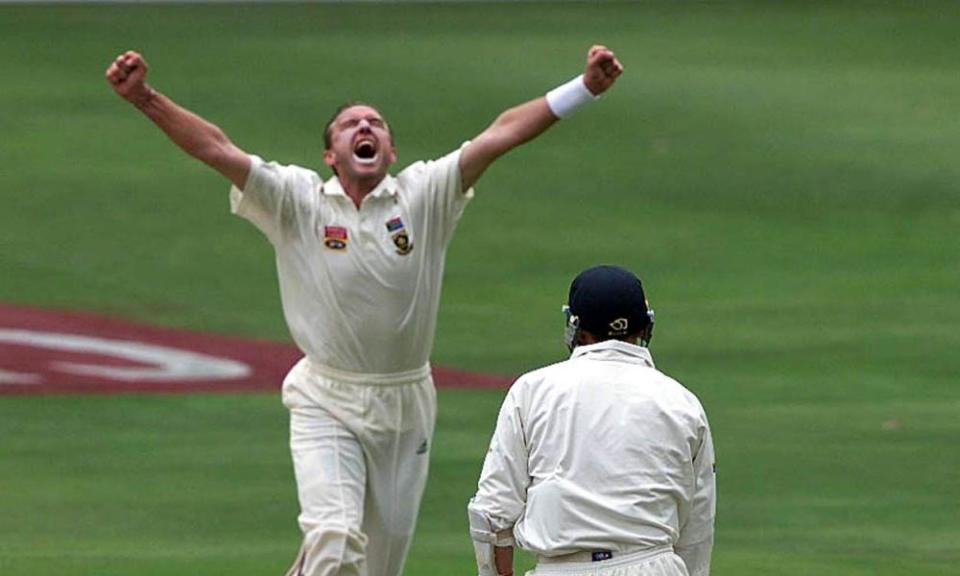Brains as well as brawn: South Africa fast bowlers are more than just brutes
Some time during the second one-day international between England and South Africa, while Anrich Nortje was unleashing thunderbolts in the Manchester gloom, the BBC’s lead commentator, Jonathan Agnew, wondered why the Proteas possess a seemingly endless supply of fast-bowling talent. A number of variables were mentioned but one in particular was cited as the primary reason: “Raw meat-eating Afrikaners.”
Agnew then reached for a collective noun for these brutish seamers who feast on biltong from the time they can chew. The Beeb’s statistician, Andy Zaltzman, whose father is South African, offered the term “herd”.
Agnew and Zaltzman were being complimentary. They were admiring, not ridiculing, these impressive athletes. Overt strength on the sports field is a quality highly valued in the Afrikaans community. It is often cited as a contributing factor behind the success of the Springboks rugby team and the meat-munching trope is well worn around braais (South African barbecues) across the country.
But here’s the thing. Any joke hinges on its context. And hearing two British men with very British accents talk about some of South Africa’s greatest fast bowlers in such glib terms was mildly infuriating. As a South African, I wasn’t alone.
“I’ve heard it a thousand times before and yes, it does come across as a bit demeaning,” says Allan Donald, the alpha of the Afrikaans quicks who terrorised a generation of batters, taking 330 Test wickets at 22.25 runs apiece. “It still gets to me sometimes. It does diminish the skill and tactical nous that you have to develop to be a successful bowler.”

No one could deny Donald’s genius with a ball. He could move it both ways, could hit any length at will and developed several slower balls throughout his two decades as a professional, including a 13-year stint at Warwickshire where he took 536 first-class wickets. Still, even he had to contend with the stereotypes.
“My teammates on the county scene would ask me: ‘What do you guys eat down there?’ It felt simplistic. But I knew it was mostly meant in a good way. I chose to take it in good faith.”
Not that Donald dismisses the theory out of hand. “You have to be physically fit to bowl fast,” he says, acknowledging that many of the South African bowlers of the past 30 years, including Fanie de Villiers, Morne Morkel and André Nel, for their power and poise through the crease. But that doesn’t account for the records of Dale Steyn, Makhaya Ntini, Shaun Pollock and Kagiso Rabada. What’s behind their success?
“You have to look at conditions, that’s the most important factor,” says Vincent Barnes, Cricket South Africa’s high-performance manager and a former slingy fast bowler whose best years were spent in the confines of the “non-white” leagues of apartheid South Africa. “The hardness of South African wickets, and the fact they don’t fall apart, allows us to develop fast bowlers from an early age.”
Along with their skills, South Africans cultivate a deep appreciation for this primal craft on bouncy decks. According to Barnes, captains and coaches are more likely to give a young tearaway another spell after giving up runs in their first set. This same patience is not afforded to expensive spinners or probing medium-pacers.
“It’s a mindset thing,” Donald says. “There is a South African mentality, across all cultures, that says: ‘You’re not going to beat me.’ We’re aggressive. It’s in the DNA. We want to be the main guy. It’s a rush knocking stumps out the ground and knocking guys on the head. Not everyone can do it. You feel invincible when you’re bowling with genuine pace.”
Related: Dean Elgar: ‘England’s style can go two ways. It can go south quickly’
Since the country’s readmission to Test cricket in 1992, four South Africans – Steyn, Pollock, Ntini and Donald – feature in the top 10 wicket-takers for seam bowlers. England, with Jimmy Anderson and Stuart Broad, have two. No other team has more than one. This is partly why opening batters have a lower average in South Africa than in any country that has hosted more than one Test. Unsurprisingly, the combined average of South African fast bowlers – 26.58 – is better than all their counterparts apart from Ireland’s, though they’ve played only three matches in this time.
That average rises, though, to 31.04 when playing in England, worse than Australia, Zimbabwe, Pakistan and the hosts. It is no secret bowlers need to bowl a fuller length on softer pitches. Is that anathema to the macho South African ideology?
“That was never an issue for me,” says Donald, who averaged 23.62 in England and bowled one of the most hostile spells ever seen against Michael Atherton at Trent Bridge in 1998. “Whatever length I bowled, I still wanted to hit it hard. I never had to temper my attitude or pace. I always maintained the energy on the ball. Nortje and Rabada might tweak their length, but they’ll still smash it with great intensity.”
Besides undercooked beef, something else will fuel South Africa as they seek to end a run of three consecutive series defeats against England. “We always made it personal against them,” Donald says. “We were constantly reminded this was where the game started, that Lord’s was sacred. We often joked England was our Ashes. Beating them in their home meant the world to us. This current group will feel exactly the same.”
This is an extract from our weekly cricket email, The Spin. To subscribe and get the full edition, visit this page and follow the instructions.

 Yahoo Movies
Yahoo Movies 
